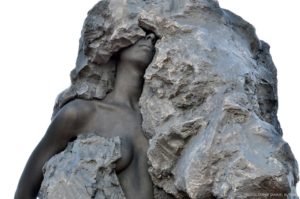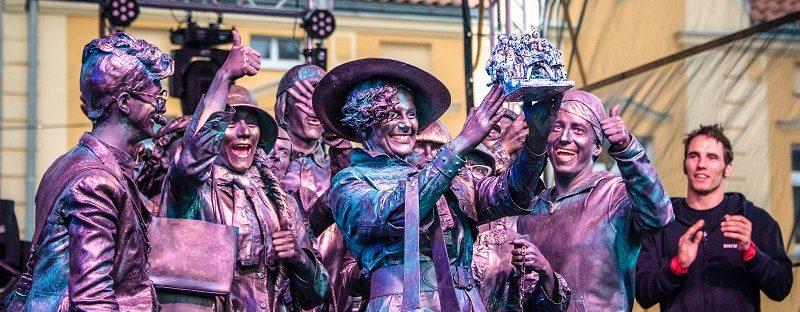Why this article?
Living statue performance is one of the most significant and amazing forms of street art in our days. From one perspective it reaches back to the oldest theatre traditions which were born on the street, and from another it started to become more popular as a street art form during the last 30 – 40 years and is still developing and growing today. Recently living statue festivals are becoming increasingly popular for those who want to make something new, unusual and engaging for audiences.
During the year I got 3 requests from people from 3 different countries asking for advice about how to organize a new living statue festival. I had questions about what values it can bring, what to consider when applying for funding, what fees are common for artists. This made me think it would be useful to share my experience with anyone thinking of organising such a festival.
Before writing this blog post I undertook a long and wonderful journey participating in and organizing a living statues festival. I had the pleasure of working as a project manager and co-artistic director of the UfO living statues festival in Poland for 5 years. Besides that I have been a living statue artist myself for over 13 years visiting festivals around the world. Today I am a founder and leader of Lutrek based in Bristol and London in Great Britain and a member of the international Living Statues Project.
Benefits & Values
What can a living statue festival bring to your region?
A living statue festival can promote an area like nothing else can. It’s not only something unique and new but will also bring your town or city to life, filling it with happiness and putting it on the map! In addition:
- It brings media coverage. Even small festivals such as the UfO festival in Poland attract mainstream media attention as it’s a super-cool and awesome event!
- Every town/city which organizes the living statues festival becomes better known, people talk about it and share photos on social media. Investors may become interested as well.
- Photographers love it.
- It is very much about audience participation. There is no other street art form which involves the public so much.
- It is an amazing way to deliver a street art form to all citizens, no matter how much money they have. It does not exclude anyone.
- It brings the most vibrant and the oldest form of human theatre, which is a street art, to your door!
- Living statue art is still being redefined and reinvented and it’s probably the most interesting street performing art that is growing in popularity in both Europe and the World. People are asking things like, what is it about? How they can stay so still? Are they real people? What do they do?
- You can view a few short videos from a few living statue festivals here: video I, video II, video III, video IV
- See my other blog post discussing what values living statues bring to an event here.
How to start?
You probably have some idea of how you want the festival to look like. It may be a self-contained event using just living statues, or it may be part of a wider concept. Have a look at a few tips which will help you to make it a fantastic and successful event:
- Talk to professional and experienced living statue artists who have visited different festivals. Ask them what’s important. Try to do a few interviews and understand their needs and the nature of their work. Ask what common mistakes other festivals make. Why do audiences like to come back to some festivals? What else should you consider?
- Even if you’re experienced, always ask your participants for feedback. This will help you to grow and develop. When I have been working for festivals myself, feedback always made us work better and brings new solutions and ideas. It’s worth knowing that the best festivals in the world are those which ask participants for feedback.
- If possible, visit other living statue festivals.
- Try to talk with other festival organisers, they may be happy to give you advice, and share experiences, and some creative cooperation may bring a new light to your festival.
How many statues do I need to invite to make it work? How long can they perform?
Nowadays we have festivals which invite different numbers of artists, from 10 to over 100. Both can work marvellously! It all depends on your budget and concept but you don’t need a huge amount of statues to make a wonderful, charming and family friendly event. For the first UfO Festival we invited 10 living statue artists plus a few street theatre groups. It worked really well. It brought us amazing feedback and opportunities to get more funding for future festivals.
Most living statue festivals have a time-frame of 4 – 5 hours. During this time living statue performances can last for a variety of different times, for example: 1 x 60 min, 2 x 60 min, 3 x 40/45 min, 4 x 40/45 min, 3h long with no breaks. It depends on the act’s specific requirements. Ask artists in the application form or email how long their performance lasts for. You can suggest what timing and sets work best for your festival but give them space to explain their specific needs, so you don’t miss some superb acts just because of the lack of flexibility.
It is worth knowing that living statues usually don’t stay in the costume longer than 4, 5 or max 6 hours because many costumes and full make-up limits the amount of oxygen that they are getting. Some of the performer’s muscles cannot relax or stretch in often stiff and heavy costumes. The make up does not look ideal after a few hours. That’s why it’s an individual thing how long people can perform and stay in costumes – it depends on the act and type of costume and make up.
For example an extraordinary living statue: DEVENIR – a World Champion winning act, performed by Helena Reis, can only perform for a very limited time for this act. I asked her why she can perform for only 1h and why she cannot go back to her performance after taking a break.
She explains: “From my previous experience, I’ve concluded that 1h is the best, for two reasons: firstly, that because I don’t move, the body needs to take a break from the still position, and secondly, when it’s too hot 1h is the limit before my body starts to overheat. When I get out of the rock, the body paint is damaged, so I would have to apply it all over again. That means it would take half an hour shower plus another 1h of body painting.”

DEVENIR by Helena Reis, World Champion in 2012 at the World Living Statue Festival, Arnhem, Netherlands, Photo: Samuel Buton
The first letter, applications and festival forms
Most festivals send an email to living statue artists asking for applications. They usually upload announcements on Facebook, social media groups and websites as well. Apart from basic information such as date, place of festival, attached application form, make sure you tell artists at this point what you provide and what the specific roles are at your festival, such as: accommodation, per diems/meals, performance fee, travel/ travel costs and artists are welcome to busk during their performance.
Application forms usually ask for the specifics of the act and performance, technical requirement, pedestals, pictures, links to websites or videos, the price (if it’s not the same for all the artists), time and sets of the performance, where they are coming from, transport costs etc.
After selection based on the applications, it helps to send a festival form asking for more specific details needed for the contract, flights, booking etc. Personally I found applications and follow-up forms very helpful, and it sped up my work significantly.
Being an artistic director – how to choose artists
You can have a specific concept or go for what you think is the most interesting from the applications you’ve received. Sometimes from seeing their proposals, other concepts can emerge. It helps to choose artists with bigger teams or at least asking for the opinion of one more person you trust.
I would suggest it’s worth remembering that you will have two major groups in your audience: adults and children. It may be wise to invite a few statues who are specifically good for an audience of children.
Personally I believe it’s good to invite famous, successful and established artists as well as giving a chance to those who are beginning their professional journey and it’s always good to consider gender balance when inviting performers. It is up to you.
Looking after your artists
Remember that any festival will work better and enjoy a better reputation if the artists are happy. In my experience the most successful festivals consider every artist’s individual needs and sometimes just small gestures can have a huge impact on the perception of your festival. For example, perhaps it’s worth considering how you approach female artists or families with young children, when they are staying away from home. I have seen some sympathetic festivals which agreed to host an extra person – a nanny, so that both parents could perform. Another festival allowed a breastfeeding mum to come with her partner, so he was able to take care of the child while she was performing etc. In my eyes it’s always beneficial to promote positive values as part of your festival planning.
What categories of living statue artists should you consider?
There are festivals who only employ professional living statues but you can also think of involving children, amateurs and families. For that to happen, you would need to organise workshops well in advance of the festival. The workshop should show how to make a living statue costume and the basic techniques of how to perform as a living statue. This will involve the local community, which always brings a friendlier image to your festival. You can find plenty professional artists specializing in such workshops, such as: Beeldje.nl from Netherlands or Lutrek from the UK.
Competition & Prizes
You might choose to have artists to compete against one another or simply skip this. Both can work superbly. For instance, the World Living Statue Festival World Living Statue Festival in Netherlands gives 3 rewards to 3 categories of participants: professionals, amateur and children. Other festivals choose the winner by having the public vote for their favourite living statue. You can create your own idea of how to run a competition or just leave it.
If you do chose to have a competition you should consider the prize. It could be an object, something like a stunning sculpture or a collection of books for the winner. Another way, which is more common, is a monetary prize.
In the past several festivals have tried to organize a competition giving a huge monetary prize for the winners instead of paying the artists a fee. They all failed because they didn’t get the quality of performers they were expecting. Some of them changed the concept and decided to pay the artists along with a competition prize for the winner and that proved to be successful.
What logistics do you need to consider?
When organizing a festival you will never stop learning, which is a very exciting part of this work. The best way to deal with unexpected situations is to make yourself as well prepared as you can be. Here’s a list of the major logistics you should consider:
Fees and busking
- Payment – make the rules clear!
- Make it clear when and what you are going to pay. It should be in the contract.
- It will make it easier and less stressful if you have a transparent and correct fair payment policy.
- The Fee
- You can establish the same payment for everyone or ask how much each artist charges and negotiate individually. It’s up to you.
- Keep in mind that living statue artists don’t collect enough money in their hats to correspond to a fee so they always require payment. Hat money can really only be considered as an extra tip
- Make sure you consider all additional costs for artists so there are no hidden ones.
- It’s worth knowing that in Great Britain the artists union Equity have been taking an interest in organizations which are not willing pay the artists fee.
- Busking – make the rules clear
- Most of living statue festivals allow the artists to busk as an additional tip. Personally I think it’s better to allow them to busk as it is the nature and tradition of street performance. Children especially enjoy participating by dropping coins into the hat. Some of the audience members often want to express a special “thank you” by giving a tip.
- Remember busking money will NOT replace the fee as I mentioned above.
- There are festivals which don’t allow busking but have a good reason for it. For example in some countries busking is simply illegal.
- If you don’t want performers to busk, make sure you make that clear in advance.
General organization
- Organization and contact information about the festival, such as: contact on arrival, festival manager contact, hotel address, day schedule etc. should be sent to the artists before they arrive.
- Transport from/to the airport in your country (if you invite artists from abroad)
- Sometimes artists will be arriving late night or after long journeys (waking up in the middle of the night, spending hours at airports), that’s why most of living statue festivals I know both pick artists up and return them back to the airport. I believe this should be a basic standard, not complicated to organize.
- Accommodation for artists
- Some artists might require a single room or so on, it’s beneficial to let them know what type of accommodation you can provide.
- Meals
- Always consider that you might have vegetarians and vegans in the group.
- Changing area and place for breaks
- Changing area with access to the toilets and showers (if possible) not far away from the performing space.
- Prepare changing area in such a way that it’s easy to clean up afterwards. Statues can leave bits of makeup and body paint on the floor, tables, chairs etc.
- There should be some long mirrors available.
- Worth announcing that any sprays should be used outside! Some people are allergic to sprays (acetone) and it’s not healthy to spend hours in a room where strong smelling sprays have been used. Unfortunately not all artists think about this.
- Place for breaks
- Living statue cannot take a break on the street where a crowd will always surround them.
- They can’t have a long distance to walk to a rest as they usually can’t walk fast wearing their costumes or they might have difficulties with it.
- You can organize the changing area a bit further away but the place to have a break between sets should be not further than 5 min slow walking distance from the performance area. It can be in the back room of a local pub or shop etc.
- Supply drinking, bottled water and snacks for artists at all times during the performance.
- Timing
- See if you can provide volunteers to let statues know that it’s a time for break unless you can find another solution.
- Pedestals
- Either statues can bring own ones or you can organize it for them, or both.
- Statues from abroad usually won’t be able to bring it.
- Placard/sign
- Your audience loves to see where an artist is from, who they are, the title of their act and their company name. Most festivals prepare a placard next to each artist, for example:

- Your audience loves to see where an artist is from, who they are, the title of their act and their company name. Most festivals prepare a placard next to each artist, for example:
- Nowadays people of different nationalities live in different countries. That’s why festivals sometimes put 2 flags on the placards. Personally I am Polish and I live in the UK, so I represent either the Polish nationality or both citizenships (and therefore both flags).
Media, Team & Technical
- Media
- Ask your chosen media for media patronage (it works differently in different countries).
- Advertising
- Flyers, gadgets and social media etc.
- Organization team
- The email correspondence with artists should be done in responsible and friendly manner. This will present your festival favorably in the eyes of the artists (and the community).
- How you work with your team will usually reflects the general atmosphere of your festival. That’s why a professional attitude when organizing – making the team feel they’re participating in a good, amazing, artistic, project with clear roles – is always beneficial. Security and all needed city permissions (for example: permission to use a public space, music etc, Zaiks – if some artists use music etc.)
- Health & Safety (fire brigade, ambulance, toilets etc.).
- Logistics
- Hire somebody who specializes in logistics, especially if the festival is bigger and you’re likely to have a big crowd.
- Gather volunteers, who will help and assist.
- Be prepared for the weather
- Make sure you have a plan B for rain, storms and bad weather.
- Organize a well prepared team, who knows what to do in respect of bad weather.
- Big transparent umbrellas for artists may help when the rain is just light.
- Remember that living statue costumes CANNOT get wet – it will destroy them.
Which living statues festivals are the best organized in my opinion?
There are plenty of amazing festivals which are organized superbly. One which I would highly recommend is the Belding Lommel Festival in Belgium. It is a 2 day festival, brilliantly organized in term of logistics, rules, artists and audience comfort. Every time I’ve visited there I felt like the area they chose for me to perform in was as if it had been made for my statue. I found this festival very inspirational for my acts.
Good luck!
Please leave your comments below!
Links I used in this blog post:
Blog post: here
Written by Izabela Walkowiak-Radcliffe

